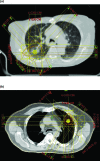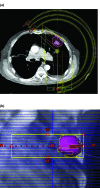Off-target-isocentric approach in non-coplanar Volumetric Modulated Arc Therapy (VMAT) planning for lung SBRT treatments
- PMID: 29296404
- PMCID: PMC5746336
Off-target-isocentric approach in non-coplanar Volumetric Modulated Arc Therapy (VMAT) planning for lung SBRT treatments
Abstract
Purpose: Volumetric Modulated Arc Therapy (VMAT) has emerged as an efficient alternative to traditional three-dimensional (3D) non-coplanar conformal (3D-NC-C) beams for lung cancer stereotactic body radiotherapy (SBRT) because of its superior dosimetric properties and native ease in planning and treatment delivery. However, patient immobilization in lung SBRT often presents challenging geometrical clearance issues in the execution of large (in excess of 180°) non-coplanar arcs. In this study, we present an off-target-isocentric, non-coplanar VMAT (OTI-NC-VMAT) technique that appears to be simple, dosimetrically robust and allows for ample patient/couch-gantry clearance. We compared this technique to a target-isocentric, non-coplanar VMAT (TI-NC-VMAT) technique and the 3D-NC-C beams for dosimetric evaluations.
Methods: Nineteen lung cancer patients previously treated with 3D-NC-C SBRT technique at our institution were selected. For each patient, an OTI-NC-VMAT plan and TI-NC-VMAT plan were created and compared to the original 3D-NC-C treatment plan. All of the plans were created for the same prescription dose of 54 Gy total in 3 fractions, covering 95% of the planning target volume (PTV). Nine to ten non-coplanar beams were used for the 3D technique and three non-coplanar arcs were used in both the TI-NC-VMAT and OTI-NC-VMAT plans, with the couch set at ± 20° and 0°, with each arc rotation in excess of 180°. Progressive Resolution Optimizer (PRO) in Varian Eclipse version 11 was used for all of the treatment planning. Conformity Index (CI), conformity number (CN), gradient index (GI), maximum dose at 2 cm away from the PTV (D2cm), mean lung dose (MLD), V20, V5 and mean target dose (MTD) were analyzed for all of the plans. We also performed statistical analysis to examine differences in the dosimetric indices between 3D and VMAT techniques.
Results: Dosimetric indices CI, CN, GI, V20 and MTD values were similar, within 5%, for all three plans: 3D-NC-C, TI-NC-VMAT and OTI-NC-VMAT. However, both types of VMAT plans were dosimetrically superior to 3D conformal plans in organ-at-risk (OAR) sparing; D2cm, MLD, and V5 values were significantly lower at 6-8%, 9-12% and 26-30% in VMAT plans, respectively. The OTI-NC-VMAT plans showed equivalent plan quality to the TI-NC-VMAT plans and exhibited robust freedom from limiting arc rotation due to potential patient/couch-gantry collision.
Conclusions: The OTI-NC-VMAT plans appear dosimetrically equivalent to TI-NC-VMAT plans for lung SBRT, while permitting large angle arc selection, free from obstructional limitations. Both OTI-NC-VMAT and TI-NC-VMAT plans were dosimetrically superior to 3D-NC-C plans in terms of organ-at-risk (OAR) sparing.
Keywords: 3D conformal; Lung cancer; SBRT; VMAT; hypofractionation; non-coplanar; off-target.
Figures










Similar articles
-
Volumetric modulated arc planning for lung stereotactic body radiotherapy using conventional and unflattened photon beams: a dosimetric comparison with 3D technique.Radiat Oncol. 2011 Nov 9;6:152. doi: 10.1186/1748-717X-6-152. Radiat Oncol. 2011. PMID: 22070866 Free PMC article.
-
Improvement of conformal arc plans by using deformable margin delineation method for stereotactic lung radiotherapy.J Appl Clin Med Phys. 2018 Jan;19(1):184-193. doi: 10.1002/acm2.12237. Epub 2017 Dec 7. J Appl Clin Med Phys. 2018. PMID: 29218841 Free PMC article.
-
Dosimetrically motivated beam-angle optimization for non-coplanar arc radiotherapy with and without dynamic collimator rotation.Med Phys. 2024 Feb;51(2):1326-1339. doi: 10.1002/mp.16899. Epub 2023 Dec 22. Med Phys. 2024. PMID: 38131614
-
Plan evaluation indices: A journey of evolution.Rep Pract Oncol Radiother. 2020 May-Jun;25(3):336-344. doi: 10.1016/j.rpor.2020.03.002. Epub 2020 Mar 4. Rep Pract Oncol Radiother. 2020. PMID: 32210739 Free PMC article. Review.
-
Planning issues on linac-based stereotactic radiotherapy.World J Clin Cases. 2022 Dec 16;10(35):12822-12836. doi: 10.12998/wjcc.v10.i35.12822. World J Clin Cases. 2022. PMID: 36568990 Free PMC article. Review.
Cited by
-
Quantitative beam optimization for radiotherapy of peripheral lung lesions: A pilot study in stereotactic body radiotherapy.J Appl Clin Med Phys. 2025 Apr;26(4):e70029. doi: 10.1002/acm2.70029. Epub 2025 Feb 22. J Appl Clin Med Phys. 2025. PMID: 39985560 Free PMC article.
-
Dosimetric comparison of coplanar and noncoplanar beam arrangements for radiotherapy of patients with lung cancer: A meta-analysis.J Appl Clin Med Phys. 2021 Apr;22(4):34-43. doi: 10.1002/acm2.13197. Epub 2021 Feb 26. J Appl Clin Med Phys. 2021. PMID: 33634946 Free PMC article.
References
-
- American Cancer Society. (2014). Cancerfacts & figures 2014. from http://www.cancer.org/research/cancerfactsstatistics/cancerfactsfigures2...
-
- Videtic G., Stephan K., Reddy C. et al. Intensity-modulated radiation therapy-based stereotactic body radiotherapy for medically inoperable early-stage lung cancer: excellent local control. Int J Radiat Oncol Biol Phys, 2010; 77: (2), 344-349. - PubMed
-
- Nagata Y., Takayama K., Matsuo Y., Norihisa Y., Mizowaki T., Sakamoto T., Sakamoto M., Mitsumori M., Shibuya K., Araki N. et al. Clinical outcomes of a phase I/II study of 48 Gy of stereotactic body radiotherapy in 4 fractions for primary lung cancer using a stereotactic body frame. Int J Radiat Oncol Biol Phys, 2005; 63: 1427-1431. - PubMed
-
- Xia T., Li H., Sun Q., Wang Y., Fan N., Yu Y., Li P., Chang JY. Promising clinical outcome of stereotactic body radiation therapy for patients with inoperable Stage I/II non-small-cell lung cancer. Int J Radiat Oncol Biol Phys 2006; 66:117-125. - PubMed
LinkOut - more resources
Full Text Sources
